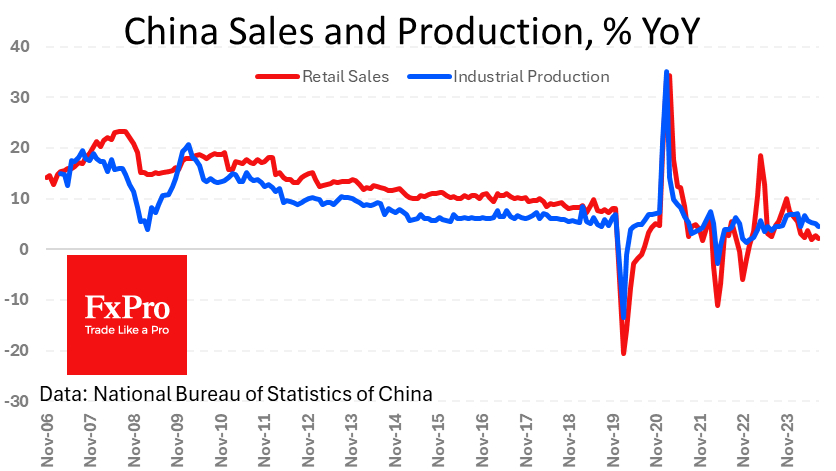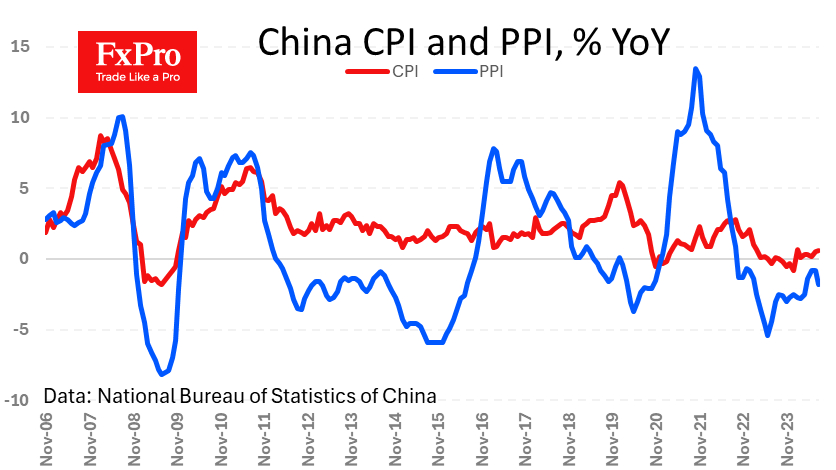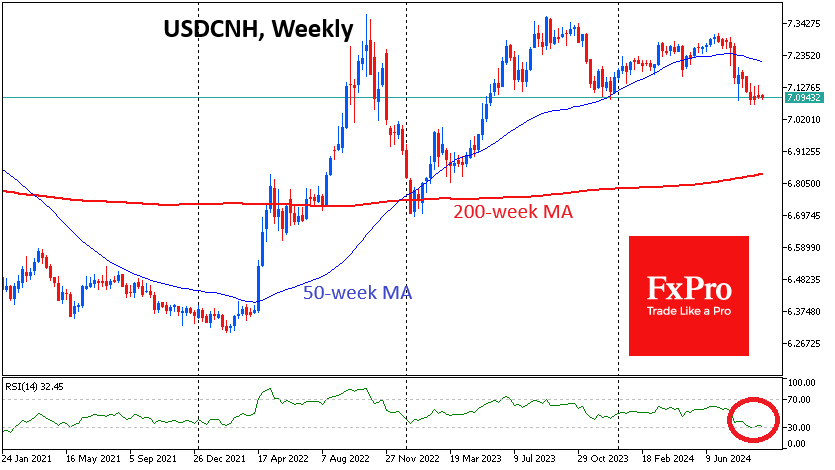Saturday's statistics from China added to fears of a slowdown in the world's second-largest economy, forcing the central bank to promise additional measures to lower borrowing costs. This is a fresh attempt to reverse the deteriorating trend in the economy and support the stock market, but the Chinese Yuan exchange rate could be a victim of this policy, although it may take some time for the effect to be felt.
All of China's key data released on Saturday were weaker than expected and showed a deterioration from the previous month. New home prices accelerated to 0.73% and fell to 5.3% y/y. Industrial production rose 4.5% y/y vs. 5.1% the previous month and 4.7% expected. Production last grew at a slower pace in July 20/23, and the slowing trend has been in place since April. Retail sales also rose only 2.1% y/y.
At the beginning of last week, inflation figures were released that were weaker than expected, with CPI up 0.6% y/y and PPI down 1.8% y/y. The sharp reversal in producer price dynamics indicates a new deflationary spiral in China. The inflation dynamics have paved the way for further monetary or fiscal stimulus.
The Chinese yuan has grown by 3% against the dollar since its lows in early July, but it is unlikely that its appreciation has had such an impact on the economy. Rather, this pullback is creating a favourable environment for interest rate cuts, which is a factor in the currency's weakness.
From roughly the same area, just below 7.10, the USDCNH pair reversed to the upside at the end of last year. Technical oversold conditions on the weekly timeframes suggest that the chances of a bounce are higher than those of a continuation of the decline. There are no significant technical headwinds for the USDCNH to the 7.3 area, and this weakening of the yuan has the potential to revive inflationary momentum and demand for Chinese goods.
The FxPro Analyst Team
- English (UK)
- English (India)
- English (Canada)
- English (Australia)
- English (South Africa)
- English (Philippines)
- English (Nigeria)
- Deutsch
- Español (España)
- Español (México)
- Français
- Italiano
- Nederlands
- Português (Portugal)
- Polski
- Português (Brasil)
- Русский
- Türkçe
- العربية
- Ελληνικά
- Svenska
- Suomi
- עברית
- 日本語
- 한국어
- 简体中文
- 繁體中文
- Bahasa Indonesia
- Bahasa Melayu
- ไทย
- Tiếng Việt
- हिंदी
Weak Chinese Data Paves the Way for Lower Yuan
Published 09/16/2024, 10:23 AM
Weak Chinese Data Paves the Way for Lower Yuan
Latest comments
Loading next article…
Install Our App
Risk Disclosure: Trading in financial instruments and/or cryptocurrencies involves high risks including the risk of losing some, or all, of your investment amount, and may not be suitable for all investors. Prices of cryptocurrencies are extremely volatile and may be affected by external factors such as financial, regulatory or political events. Trading on margin increases the financial risks.
Before deciding to trade in financial instrument or cryptocurrencies you should be fully informed of the risks and costs associated with trading the financial markets, carefully consider your investment objectives, level of experience, and risk appetite, and seek professional advice where needed.
Fusion Media would like to remind you that the data contained in this website is not necessarily real-time nor accurate. The data and prices on the website are not necessarily provided by any market or exchange, but may be provided by market makers, and so prices may not be accurate and may differ from the actual price at any given market, meaning prices are indicative and not appropriate for trading purposes. Fusion Media and any provider of the data contained in this website will not accept liability for any loss or damage as a result of your trading, or your reliance on the information contained within this website.
It is prohibited to use, store, reproduce, display, modify, transmit or distribute the data contained in this website without the explicit prior written permission of Fusion Media and/or the data provider. All intellectual property rights are reserved by the providers and/or the exchange providing the data contained in this website.
Fusion Media may be compensated by the advertisers that appear on the website, based on your interaction with the advertisements or advertisers.
Before deciding to trade in financial instrument or cryptocurrencies you should be fully informed of the risks and costs associated with trading the financial markets, carefully consider your investment objectives, level of experience, and risk appetite, and seek professional advice where needed.
Fusion Media would like to remind you that the data contained in this website is not necessarily real-time nor accurate. The data and prices on the website are not necessarily provided by any market or exchange, but may be provided by market makers, and so prices may not be accurate and may differ from the actual price at any given market, meaning prices are indicative and not appropriate for trading purposes. Fusion Media and any provider of the data contained in this website will not accept liability for any loss or damage as a result of your trading, or your reliance on the information contained within this website.
It is prohibited to use, store, reproduce, display, modify, transmit or distribute the data contained in this website without the explicit prior written permission of Fusion Media and/or the data provider. All intellectual property rights are reserved by the providers and/or the exchange providing the data contained in this website.
Fusion Media may be compensated by the advertisers that appear on the website, based on your interaction with the advertisements or advertisers.
© 2007-2025 - Fusion Media Limited. All Rights Reserved.
